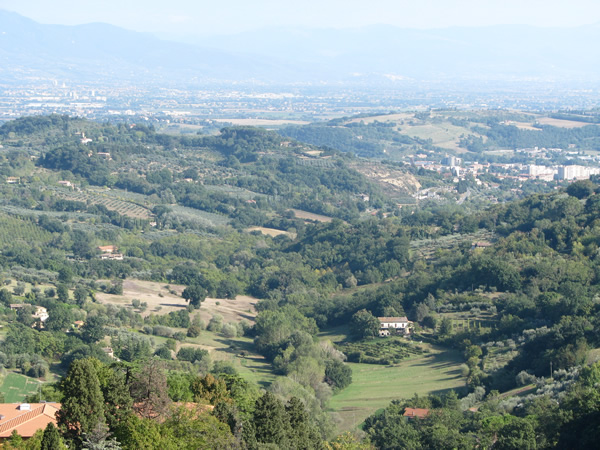Language Learning in Perugia, Italy
It’s Never Too Late to Learn Italian
By Christina Bezaire
 |
| A view from the city of Perugia, in the Umbria region of Italy. |
After living for a month as part of an Italian household and studying at the university for foreigners in the historic city of Perugia,
Italy, I am convinced that anyone, young or old, can learn to speak Italian in Italy and do it on a budget.
I chose L’Universita per Stranieri di Perugia for its month-long course that starts on the first of every month. The course is
offered at five levels, beginning to advanced. I registered by mail and paid tuition and fees prior to starting class.
The quality of instruction varied during the 21 hours of weekly class time. One outstanding instructor kept the class so busy talking — about
Italy and about her life and ours — that the hours flew by. She cheered us on as we used our growing command of Italian to bridge the gaps among our various
ages, nationalities, and occupations.
The university classrooms are in an historic palazzo, and from my classroom window I looked out on an Estrucan arch and the remains
of a wall built over 2,000 years ago. The ancient walled city has kept much of its medieval character; streets too narrow for automobiles wind through blocks
of connected stone houses. My class schedule left plenty of time to explore the small but historically significant town and the nearby cities of Todi, Deruta,
and Assisi.
Agencia Periscopio, a school-recommended housing agency, offers the option of renting an entire apartment, sharing a flat, or rooming
with families. To maximize my cultural immersion, I requested a room in an Italian home. An elderly widow and her adult daughter took me in, along with two
college-age girls, one Turkish and one Japanese. I ate my main meals in local restaurants, but during my morning coffee and yogurt in the kitchen I practiced
my Italian with other household members.
At $300 for the month plus a $36.50 supplement for use of the kitchen, my housing costs were high compared to
those of other students, but La Signora was gracious and kept an immaculate and quiet household — with women silently padding about the halls and everyone
asleep by 10 p.m.
Tips: High in the hills of Umbria, Perugia can be cold in March, the month of my visit, and because of the high cost of fuel the heat
is rarely turned on. It’s better to go in late spring or early fall when the weather is warmer and the crowds of tourists have not yet arrived. Also,
if comfort and privacy are important for you, the luxury of a private apartment may be worth the extra cost. Several classmates told me of small apartments
with kitchenettes that were advertised privately for around $365.
Proximity to the school is essential. If you can’t find a place you want through one agency, ask the school to recommend another.
Or wait until you arrive in Perugia, stay in a hotel for few days, and search for your ideal situation. The Hotel Priori is centrally located and reasonably
clean. The local classified publication, Cerco e Trovo, sold at newsstands, lists apartment rentals.
The APT tourist office at Piazza IV Novembre will provide a list of rooms rented on a weekly or monthly basis. Finally, crowds of prospective
landlords gather daily in front of the school, willing to offer you a place to stay . . . and maybe a window into Italian life.
Visit Language Learning at the Università per Stranieri di Perugia for more information on their Italian language study program.
CHRISTINA BEZAIRE left a law practice in California for a life overseas. She has lived, traveled, and worked in China and
Italy.
|
